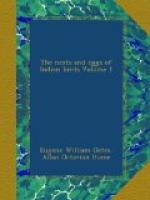Mr. C.J.W. Taylor, writing from Manzeerabad, Mysore, says:—“Fairly common throughout the district. Eggs taken on the 15th July, 1882.”
Mr. Rhodes W. Morgan, writing from South India, remarks:—“It builds a neat pendent nest in long grass on the Nilgiris. The nest is composed entirely of short pieces of grass fitted together, and is very compact. The eggs are three in number, and are of a blue colour, with large blotches and hair-like streaks of a dark reddish brown at the upper end. An egg measured .69 inch by .5.”
The eggs of this species do not differ materially in size, shape, or markings from those of P. inornata which are very fully described above.
468. Prinia blanfordi (Walden). The Burmese Wren-Warbler.
Drymoeca blanfordi, Wald., Hume, cat. no. 543 ter.
Mr. Oates, who found this bird very common in Pegu,
writes:—“The
Burmese Wren-Warbler is perhaps the commonest bird
of the Pegu plains.
From Myitkyo on the Sittang, and possibly from further
north, down to
Rangoon, it is to be found in all the low tracts covered
with grass.
“Where it occurs it is a constant resident and breeds from May to August. I have found the nest in the middle of May, but it is not till July that the bulk of the birds lay.
“The nest is never more than 4 feet from the ground, and is attached either to two or more stalks of elephant-grass or to the stem of a low weed, or to the blades of certain tender grasses which grow in thick tufts. There is little or no attempt at concealment. The materials forming the nest are entirely fine grasses, of equal coarseness or fineness throughout, gathered green, and so beautifully woven together that it is almost impossible to destroy a nest by tearing it asunder, although it may be looked through. In shape it is somewhat of a cylinder, with a tendency to swell out at the middle. Its length, or rather height (for its longer axis, being invariably parallel to the stalks to which the nest is attached, is generally upright), is from 6 to 8 inches, and its extreme width 4. The entrance is placed at the top of the nest, the sides of which are produced an inch or two above the lower edge of the entrance. The thickness of the walls is very small, seldom reaching half, and generally being only a quarter, of an inch. Occasionally the nest is almost globular, but the back of the entrance is in every case produced upwards some inches. There is no lining at all.
“The eggs never exceed four, and frequently are only three, in number, and the female does not commence sitting till the full number is laid. She deserts the nest on the slightest provocation; and if a nest with only one or two eggs is found, and the fingers inserted, it is useless to leave the eggs in hopes of getting more. She will lay no more. I have tested this in at least ten cases.”
Major C.T. Bingham tells us:—“About Kaukarit, on the Houndraw river in Tenasserim, I found this species, in June 1878, very common. They were then breeding, and I found several nests, all, however, unfinished; these were, in material and make, very like the nests of P. inornata which I had taken years ago in India.”




